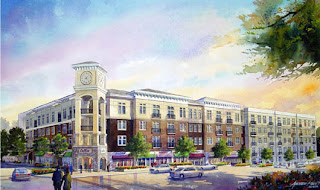 Mixed-use development is the practice of allowing more than one type of use in a building or set of buildings. In planning zone terms, this can mean some combination of residential, commercial, industrial, office, institutional, or other land uses.
Mixed-use development is the practice of allowing more than one type of use in a building or set of buildings. In planning zone terms, this can mean some combination of residential, commercial, industrial, office, institutional, or other land uses.Mixed-use development provides flexible, performance-based zoning standards. It allows residential uses integrated with commercial, employment, and civic uses in appropriate locations. Examples of this would be main streets, downtown areas, neighborhood centers, and other core places. Flexibility in the height of buildings, housing densities, lot coverages, yards being setback, landscaping, and other zoning provisions are all considered in mixed use developments. Where mixed-use development is permitted, codes should allow residential uses above or behind permitted commercial or civic uses, and the combination of compatible commercial uses (i.e. office, retail, entertainment, and services).
The idea behind Mixed use development is to also allow for small-scale commercial uses in residential neighborhoods thus allowing people to walk to nearby establishments for quick necessities, (i.e. a gallon of milk, a loaf of bread, etc) rather than having to drive to the store.
Commercial development is constantly reinventing itself. After relocating in strip-malls, commercial development is now returning to America’s downtowns and main streets. These areas are experiencing a renaissance, as people seek more intimate and pedestrian-friendly shopping experiences. Suburban commercial centers and corridors, too, are being transformed. Some big box stores are evolving into mixed-use centers with entertainment uses, and malls are turning themselves “inside-out,” using storefronts that mimic traditional downtowns. Cities are converting brownfields into urban villages with housing, retail, entertainment, and civic uses, and e-commerce is spawning small businesses in old warehouses and along main streets. All of these innovations pose opportunities and challenges for managing growth in our communities.
Principles of Mixed Use Development:
- Efficient Use of Land Resources- Efficiency means urban development is compact and uses only as much land as is necessary.
- Full Utilization of Urban Services- Use existing service capacity where available, and make the most of our infrastructure investments. Where needed size new facilities to meet the needs of the population.
- Mixed Use- Mixed-use development brings compatible land uses closer together.
- Transportation Options- Walking, Bicycling, Public Transit, and Private Transit are all included in ones transit options making communities more friendly and unified.
- Human–Scale Design- Smart design is attractive design that is pedestrian–friendly and appropriate to community character and history. The objective is to design buildings to a human scale for aesthetic appeal, pedestrian comfort, and compatibility with other land uses.
- Economic development
- Revitalization of main streets, downtowns, and neighborhood centers (reverting back to the city beautiful movement)
- Development of needed housing close to jobs and services; and the creation of jobs close to where people live
- Transportation choices and connectivity
- Walkable communities and transit-supportive development, causing a decrease in commuter congestion
- Energy conservation
 For complete information on Mixed Use Development practices: Mixed-Use Development Handbook by Dean Schwanke
For complete information on Mixed Use Development practices: Mixed-Use Development Handbook by Dean Schwanke












